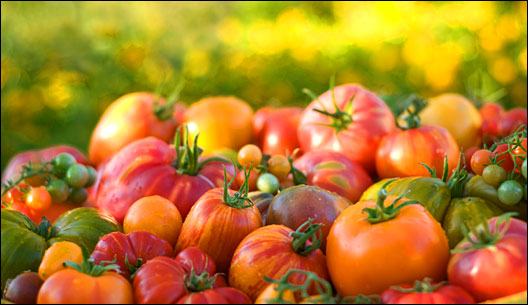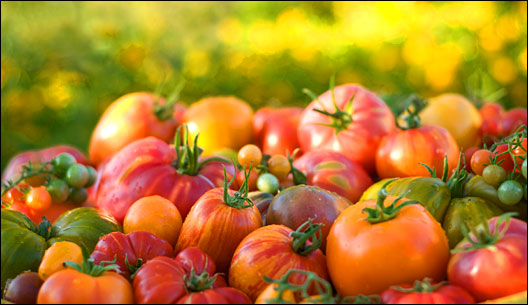
All my life, I have wanted to be a professional tomato taster. I am happy to report that on August 18, 2008, I had the chance to serve as a judge (unpaid, so, OK, not exactly professional, but still …) in the 24th annual Massachusetts tomato contest, organized by the Massachusetts Executive Office of Energy and Environmental Affairs and held at City Hall Plaza in downtown Boston.
I was actually just chilling with friends who were going to serve as judges (How pathetic is that? I am a tomato taster groupie!) when — oh lucky day! — some of the anointed judges didn’t show up (as if they had something more important to do that day than taste tomatoes! Where are their priorities?).
The organizers must have noticed how forlorn I looked hanging around on the sidelines and they took pity on me and handed me a clipboard with a sheet to fill out. A little voice inside my head (that sounded a lot like Tina Fey channeling a cartoon mouse) said, “You’ve been called up to the big leagues, kid! This is your big tomato-tasting break! You can do it!” and when they asked, “Who wants to judge cherry tomatoes?” my hand went up like a shot. (The other categories were slicing, heritage, and heaviest. There were 73 entries in all.)
I, the Jury
I took my duty seriously. There were five points to consider: taste, firmness, color, shape, and size. As you might imagine, shape and size vary a whole lot less in the cherry tomato category than in heritage or slicing, but we still had to judge whether the shapes and sizes were correct and uniform. All the cherry tomatoes had good color and their firmness was generally excellent, but the taste fell far short of the mark. We had so much rain here this summer that the lack of sun caused the flavor of the tomatoes to be very faint and “washed out.” It was as though the flavor was being whispered from the farthest corner of the plaza instead of being sung aloud with full-throated abandon by one of the nearby street performers — in short, a major disappointment.

Champion tomato specimens.
Photo: Roz Cummins
After performing the duties of my office, I took some time to look over the entrants in the other categories and listen to farmers talk about how disappointed they were in the flavor of this year’s crop. I also checked out the trophies — regular-looking trophies but with big plastic tomatoes on top. They really appealed to the kitsch hound in me, enough so that I am thinking of making one for myself, commemorating the day that I was plucked from obscurity and proudly served my commonwealth as a tomato judge. (I may sound lighthearted in my description of the proceedings, but it’s actually a serious responsibility — winners get bragging rights that enhance their sales and their reputations — and I am genuinely honored that I had the chance to serve along with all of the other food writers, chefs, gardening experts, and state officials who took the time and made the effort to come downtown.)
As for the results, Matt’s Wild, normally my favorite type of cherry tomato because it tastes more like a regular tomato rather than the sweet blast of most cherry tomatoes, came in ninth. I blame the rain. Red Fire Farm’s Sungold and Supersweet 100s took first and second place, with third going to Kimball Fruit Farm’s Sunsugar. The tomatoes had no signage on them at all during the tasting. Not only did it not say what farm they came from, but there also was no indication of what variety they were — but I can tell a Matt’s Wild from 100 paces. I am really sad that it was bested by its bigger, sweeter cousins, but that’s the way it goes. Even I had to admit that the Matt’s Wild weren’t up to par this year and I voted for the Sungold and Supersweet 100s like everybody else.
Supporting Local Farmers the Delicious Way
The purpose of the tomato festival, according to Doug Peterson, the commissioner of the Massachusetts Department of Agricultural Resources, is to boost consumer awareness about local agriculture. “Farmers can spend up to 10 hours a day preparing for and attending farmers markets and some travel as far as 100 miles away. We are truly fortunate to be able to enjoy the fruits of their labors at markets like this one at City Hall Plaza,” he said.
Ian Bowles, secretary of Energy and Environmental Affairs, gave some background on the state’s agriculture. “Massachusetts is home to over 6,000 farms, supporting more than 518,000 acres of working landscapes,” he said. “Farmers markets play a vital role in keeping these farms productive and profitable.”
As for me, I got an invitation to come back and serve as a judge next year. Maybe it won’t rain so much next year and the Matt’s Wild will have their day in the sun. (And maybe the Red Sox will win the World Series. Those two events would make me a happy woman.)
To Everything, a Season
It’s fitting that I should have the opportunity this week to write about tomatoes — my favorite food — as this is my last regular ‘Tis the Season column. I have two unfinished cookbook manuscripts sitting on my desk — one, The Official Handbook of the Society for the Preservation of Afternoon Tea, contains a year’s worth of sustainability-minded tea party menus, and the other, The Kitchen Almanac, is a seasonal flexitarian cookbook — and I need to spend the time that I usually devote to writing this column to finishing my books and finding a publisher. I will be starting a biweekly email newsletter next month and if you’d like to receive it, or if you’d like to be a recipe tester, read the instructions for signing up at my website.
In the meantime, I want to tell you how much fun it has been to write for all of you and to sometimes hear back as well. It’s been gratifying to know that I helped someone to figure out why his peanut sauce always broke (the noodles were still too hot to pour the sauce over them) and that one reader “has never bought another bottle of salad dressing since making your maple-basil dressing.” I’ve given a lot of thought to what people have said about the ethics and environmental impact of eating meat, and I’ve had the chance to consider at length what we can and cannot safely take out of the oceans.
I’ve enjoyed hearing about your family traditions and favorite dishes, and I have felt especially blessed to be able to spend time talking with all the farmers, fishers, chefs, and artisans who have shared their time and expertise with me. Other food writers and researchers have been incredibly generous with their work and knowledge as well. Good luck, have fun, and don’t forget to make time to sit down to a home-cooked meal with family and friends as often as you can — ideally one that contains foods that are local and organic.

Goodbye Garden “Gumbo”
Feeds 10-12
I developed this recipe as a way to say goodbye to the garden for the year, and to use up the loads of tomatoes that friends have given me. (I realized afterwards that it’s also appropriate since it’s my last article.)
This isn’t a true gumbo since it doesn’t have a roux — oil and flour sautéed together until they are a deep brown — as its base, but it contains many of the other flavors and ingredients that define gumbo: tomatoes, bell peppers, and okra. (I like red bell peppers, but if you like green ones, they’re fine too.) Onions and celery round out the lineup. I love the texture of new potatoes in a soup so I threw them in too, and I added some fresh sweet corn as part of the goodbye-to-summer effort. I planned to make it with cubes of smoked tofu for protein, but I ended up cooking it for some friends who are not fans of tofu, so I substituted chicken apple sausage instead.
The soup missed the smoky flavor that the tofu would have provided, though, so I added a tiny amount of liquid smoke, and that made it fantastic. (I used to be afraid of liquid smoke because I assumed it was a cocktail of chemicals and artificial caramel coloring, but it turns out that it really is just smoke! A chef who cooks natural foods turned me on to it.) You could also add smoked turkey or chicken, or smoked sausage. If you want to stay vegetarian, add beans. You could also add some cheese tortellini if you wanted to turn it into a wild and crazy minestrone.
I did all my shopping at a regular supermarket. I bought Campbell’s tomato juice, which contains tomatoes and salt, so I didn’t salt the soup at all because it already contained enough.
Music aside: Tab Benoit’s “We Make a Good Gumbo” will put you in the mood while cooking this up. (In addition to being a great musician, Tab is a long-standing wetlands advocate.)
Ingredients
2 medium onions, finely minced
2 48-oz jars of tomato juice
4 cups new potatoes, chopped into quarters
4 cups fresh tomatoes, chopped
1 bell pepper (red or green), chopped
2 ribs of celery, sliced
Kernels from 2 ears of corn, cut off the cob
1 1/2 cups okra, sliced
3/4 tsp fresh thyme
1/2 tsp dried oregano
1 tsp black pepper
Juice of 1 fresh lemon
1 teaspoon liquid smoke (if you’re not adding smoked tofu or smoked turkey or some kind of smoked sausage)
Salt to taste, if necessary
Optional add-ons
Or 1 can navy beans, rinsed and drained
Or 1 block of smoked tofu, cut into dice-sized pieces
Or 1/4 – 1/2 pound smoked turkey or chicken, cut into dice-size pieces
6 cups cooked rice if you want to serve the gumbo over rice (that’s 1/2 cup for each portion)
- Heat the vegetable oil over medium heat. Add the onion and sauté until translucent.
- Add the tomato juice.
- Add all the chopped vegetables: tomatoes, potatoes, bell pepper, celery, corn, and okra. Add the thyme and oregano. Cook for 20 minutes. Stir often to prevent the bottom from scorching. They may need another 10-15 minutes. Check periodically.
- Check the texture of the potatoes and okra. I like them kind of al dente, but you might like them a little bit softer.
- Add the black pepper. Taste to see if salt is needed; add if necessary.
- When you like the texture of the potatoes and okra, and you feel the soup is ready to serve, add the lemon juice and stir. Take the soup off the heat.
- If using rice, turn rice into each individual soup bowl by packing it into a teacup and then inverting it. Pour the soup over the rice.



